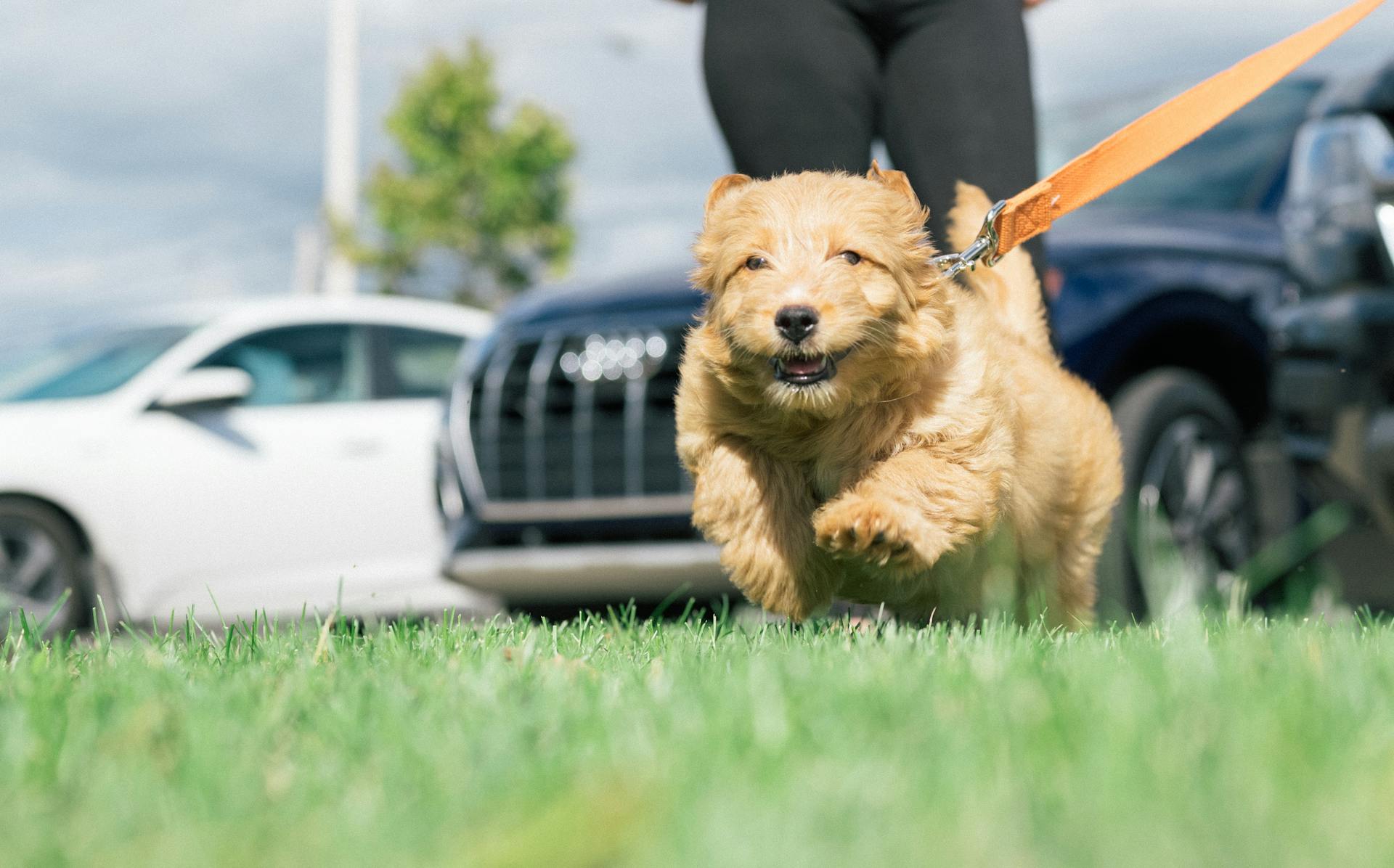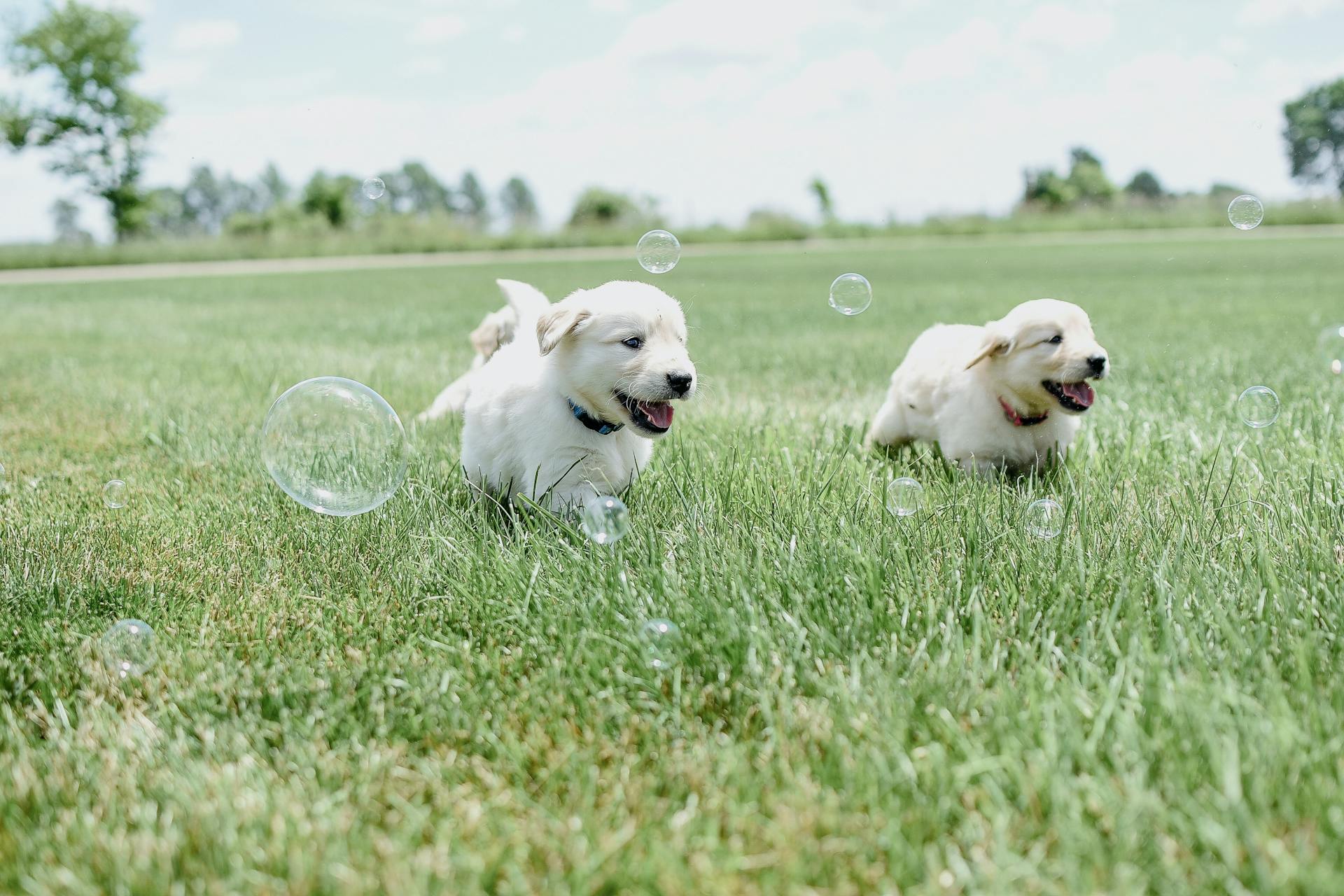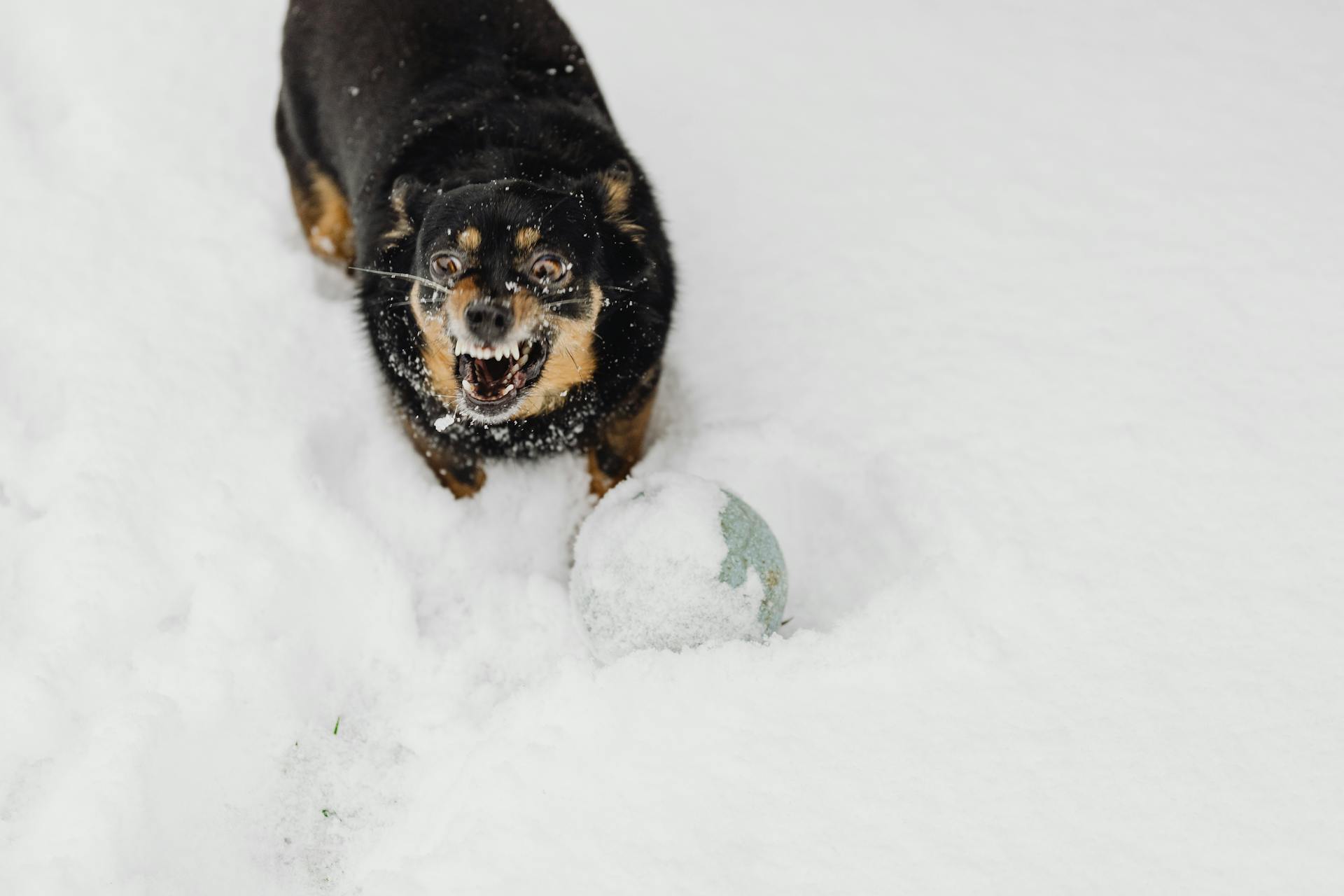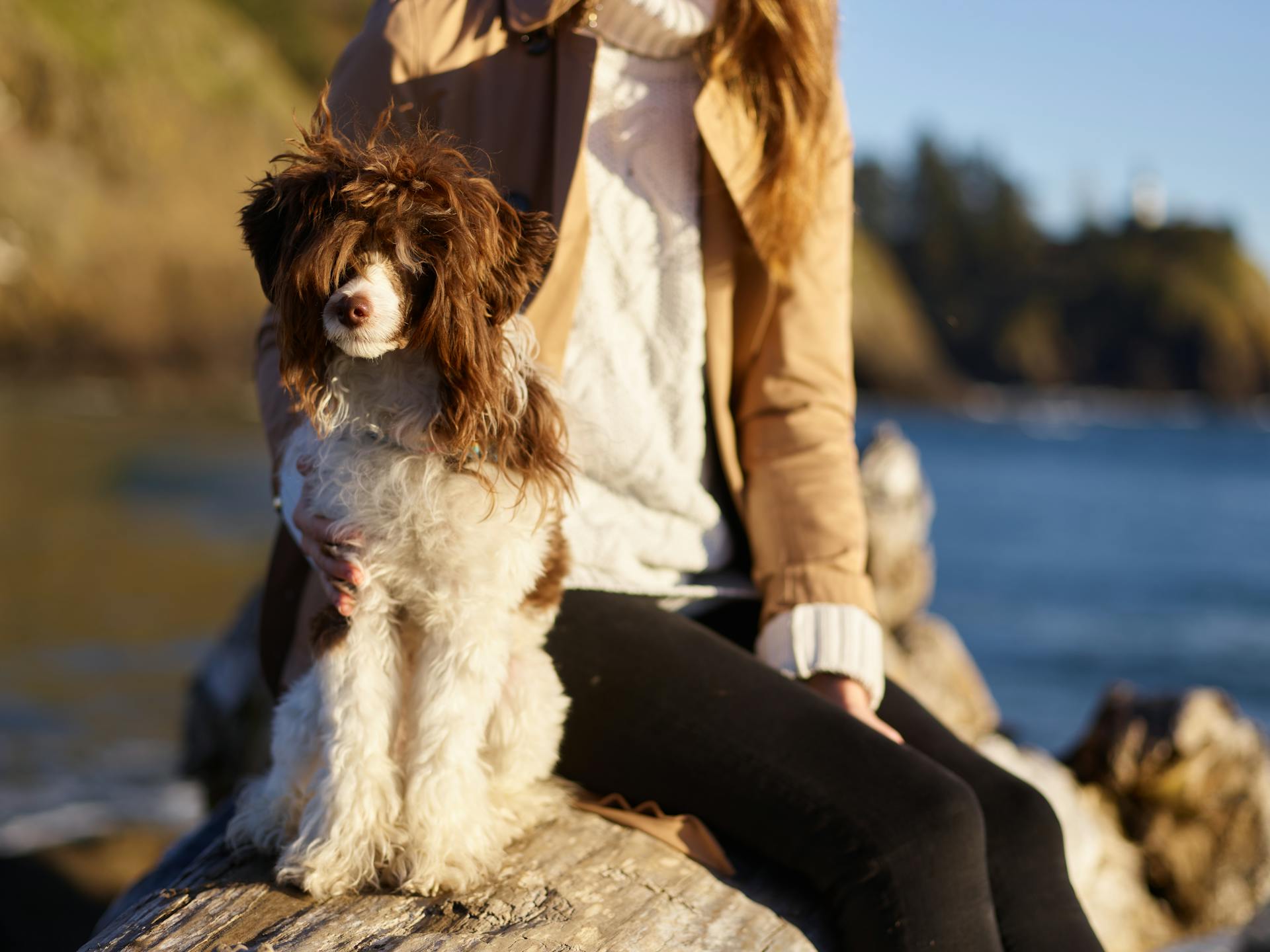
Aussiedoodles are a cross between an Australian Shepherd and a Poodle, which can make for a low-shedding dog.
They inherit the Poodle's low-shedding trait, but their Australian Shepherd heritage can sometimes lead to shedding.
Aussiedoodles can shed moderately to heavily, depending on the individual dog and its genetic makeup.
Shedding can be influenced by factors such as the dog's coat type and the climate it lives in.
If you're considering an Aussiedoodle as a pet, be prepared for regular grooming to manage their coat.
Related reading: Caucasian Shepherd Shedding
What Is an Aussiedoodle?
The Aussiedoodle is a cross between an Australian Shepherd and a Poodle, resulting in a unique and lovable breed.
They can have a curly or wavy coat type, with rarer variations present.
Their coat is often shaggier than expected but never absurdly lengthy.
On average, an Aussiedoodle will have a medium-length scruff of fur around its body that is lightly curled or winding.
Physical Characteristics
The Aussiedoodle's physical characteristics are quite varied, but one thing is certain - they come in a range of sizes, weighing between 25-75 pounds and standing between 10-20+ inches tall.
Their coat type is another distinguishing feature, with a medium curly or rippled coat being the norm.
You can expect some shedding from your Aussiedoodle, but the extent of it depends on their coat type. If they have a straight coat, they're likely to shed more.
Here's a quick rundown of the Aussiedoodle's physical characteristics:
What Do They Look Like?
Aussiedoodles have a coat that looks like the best bedhead you could ever hope for, with a thick mop of curly or wavy hair ranging from medium to medium-long.
Their size can vary wildly, with some getting above twenty inches on all fours.
Aussiedoodles are not easily categorized by appearance, as they can have a big fluff of fur that looks like a loose hairstyle around their head or a shaggy, short coat that frames their friendly face.
One distinguishing fact about Aussiedoodles is that they almost always have multiple colors throughout their fur.
The rarest variation of Aussiedoodle is red, which shades the dog in a beautiful auburn hue.
Discover more: Great Pyrenees Matted Fur
Wavy
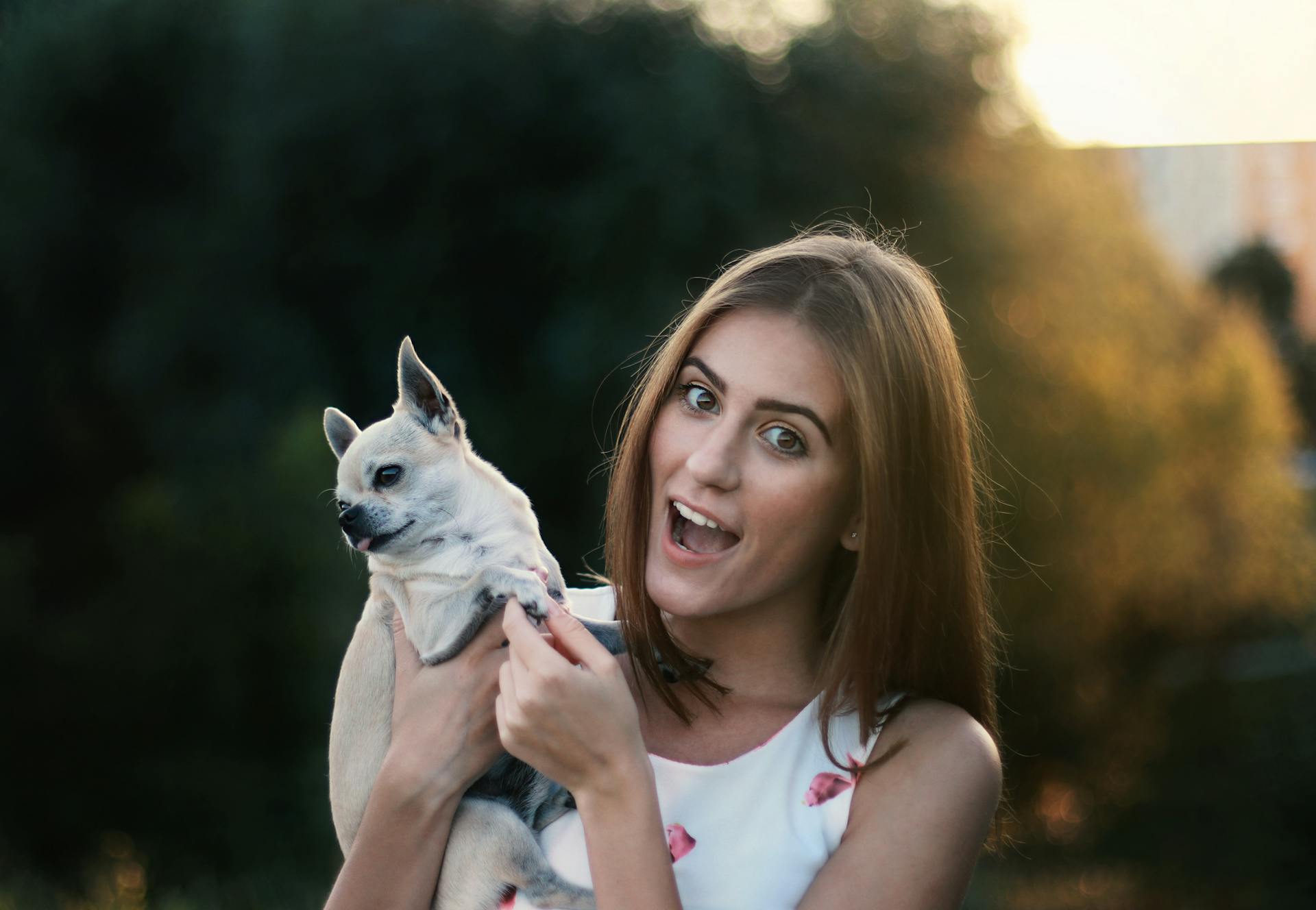
Wavy Aussiedoodles have a beautiful combination of the straight Australian Shepherd coat and the curly-haired Poodle. Their wavy coat may or may not be double-layered, but it typically sheds very little thanks to the Poodle genes in the mix.
A wavy coat Aussiedoodle's hair is usually longer and requires less attention than a curly coat, making it a great choice for those who want a low-maintenance coat. You can get away with brushing them once a week or two to keep their coat looking its best.
Aussiedoodles with wavy coats can either be single-coated or double-coated, but either way, they tend to shed very little. This makes them a great choice for people with allergies or who want a low-shedding breed.
Here are some key characteristics of wavy Aussiedoodles:
One thing to keep in mind is that wavy-coated Aussiedoodles can either be single-coated or double-coated, and the single-coated ones tend to shed even less.
But What About Smaller Dogs?
Smaller dogs, like Mini Aussiedoodles, can shed hair, especially if they're double-coated. This is determined by their coat type and genetics.
Mini Aussiedoodles bred as backcross generations are less likely to inherit more of the Poodle's traits and characteristics, which means they may shed less.
Be wary of breeders who claim to have non-shedding and hypoallergenic Aussiedoodles, as there's always a chance these pups inherit a shedding undercoat.
An Aussiedoodle's potential for shedding is directly linked to their coat type.
Brushing and Grooming
Brushing and Grooming is a crucial part of Aussiedoodle care, especially when it comes to managing their shedding. Daily brushing is the best way to go, but at least 3 to 4 times a week is a good compromise.
Aussiedoodles are prone to matting, so regular brushing is essential for their coat and skin health. You'll also be removing loose hair, saliva, and dander particles, reducing allergens on your furniture, floors, and in the air.
Readers also liked: Brushing a Cockapoo
For curly-haired Aussiedoodles, daily brushing is a must, while wavy coat Aussiedoodles require less frequent brushing. Brushing frequency also depends on how much time you spend outdoors with your dog.
It's essential to choose a sturdy and good-quality brush that can handle the demanding Aussiedoodle hair. Regular brushing will help prevent matting and tangling, making grooming easier and less painful for your dog.
Here's a rough guide to brushing frequency based on coat type:
Bathing frequency also plays a significant role in Aussiedoodle grooming. You may need to bathe your Aussiedoodle more often if they have skin conditions, or less often if they don't. Using an anti-dander or anti-dandruff dog shampoo can help neutralize allergens.
Aussiedoodles also need regular nail trims, ear cleaning, and teeth brushing. You may need to visit a professional groomer every 3 months for a retouch, and bathe them every 1 or 2 weeks.
Consider reading: Do Cocker Spaniels Need Haircuts
Reducing Shedding
Poor nutrition and diet are one of the leading causes of Aussiedoodle shedding. If your pup doesn't get all the essential nutrients it needs, it can lead to excessive shedding, hair breakage, or even bald spots.
Changing your Aussiedoodle's diet too suddenly can also cause excessive shedding. So, it's essential to introduce new foods gradually to prevent any adverse reactions.
Stress and anxiety can also contribute to Aussiedoodles shedding. Giving your pup plenty of love, attention, exercise, and mental stimulation throughout the day can help manage their stress levels.
Reducing Shedding
Genetics play a huge role in determining an Aussiedoodle's shedding habits. If your Aussiedoodle sheds, it's possible that it inherited the genes of its double-coated Australian Shepherd parent.
To minimize shedding, it's essential to understand your Aussiedoodle's genetic makeup and hair type. Hybrid breeds with Poodle in the mix tend to benefit from less shedding.
Here's a breakdown of the different generations of Aussiedoodles and their shedding levels:
An F1B Aussiedoodle, which is 25% Australian Shepherd and 75% Poodle, tends to shed the least.
Stress and anxiety can also contribute to shedding in Aussiedoodles. Providing plenty of love, attention, exercise, and mental stimulation can help manage stress and reduce shedding.
A well-balanced diet is crucial for minimizing shedding. Aussiedoodles that don't get essential nutrients from their diet may experience excessive shedding, hair breakage, or even bald spots.
Consulting with your veterinarian about possible food allergies can also help minimize shedding. Switching up the main source of protein in their diet often does the trick.
Health Issues Causing Shedding
Health issues can cause shedding in Aussiedoodles, and it's essential to be aware of the possible causes. Skin and food allergies and sensitivities can lead to excessive shedding.
Genetic makeup and coat type are not the only factors that contribute to shedding, and health issues can also play a significant role. Certain health issues can cause Aussiedoodles to shed more than usual.
Some serious medical conditions can cause abnormal shedding in Aussiedoodles, so it's crucial to monitor your dog's behavior and health closely. If you notice any unusual changes in your dog's behavior, such as lethargy or depression, book an appointment with your vet as soon as possible.
Health issues can be a significant factor in shedding, and it's essential to address them promptly to prevent further complications. By being aware of the possible causes of shedding, you can take steps to reduce it and keep your Aussiedoodle healthy and happy.
Here's an interesting read: Aussiedoodle Behavior Problems
Fleas, Ticks, and Parasites
Fleas, ticks, and parasites are common culprits behind excessive shedding in Aussiedoodles.
These pesky critters can trigger skin allergies and irritation, leading to shedding.
Parasites can be prevented or treated with proper grooming and medications, making it a relatively easy problem to solve.
Fleas, ticks, and mites are often the culprits behind skin allergies and irritation in Aussiedoodles.
Proper grooming is key to preventing parasites, so brush your Aussiedoodle regularly to keep them under control.
Fleas, ticks, and mites can be treated with medications, but prevention is always the best approach.
Aussiedoodle Types and Generations
An Aussiedoodle's shedding levels and hypoallergenic potential depend on their genetic makeup and hair type. Understanding their generation gives us a good estimate of these traits.
F1 Aussiedoodles, being 50% Australian Shepherd and 50% Poodle, are expected to shed more than those with more Poodle influence. In fact, if an Aussiedoodle takes after the Australian Shepherd, they'll likely shed more.
The following generations are more likely to inherit the Poodle's low-shedding coat: F1B Aussiedoodles (25% Australian Shepherd and 75% Poodle), F1BB Aussiedoodles (12.5% Australian Shepherd and 87.5% Poodle), and F2B Aussiedoodles (37.5% Australian Shepherd and 62.5% Poodle).
Here's an interesting read: Aussiedoodle vs Australian Shepherd
Are F1 Doodles?
Are F1 Doodles a good fit for you?
F1 Doodles have a 50-50 mix of both parental breeds, making it tricky to predict how they'll turn out.
They can inherit a mix of coat types, including wavy and curly coats.
F1 Aussiedoodles are more likely to have wavy coats than curly ones.
Some F1 Doodles may have undercoats that shed.
F1 Doodles are suitable for people with mild allergies, as they may shed a little.
It's worth noting that F1 Doodles can be a great choice for families with mild allergy concerns.
Take a look at this: Aussiedoodle Lab Mix
Are F1b?
Are F1b Aussiedoodles Hypoallergenic? F1b Aussiedoodles are considered more hypoallergenic than F1 or F2 Doodles. That's because these pups have a mix of 75% Poodle and 25% Australian Shepherd in their lineage.
Most breeders produce F1b generations by crossing an F1 Doodle back to a Poodle. F1b Aussiedoodles take more after the Poodle parent in terms of their coat type and hypoallergenic levels.
They're better suited for people with moderate to severe allergies.
A different take: Is Hypoallergenic Dogs Real
Are F1bb?
F1bb Aussiedoodles have a whopping 87.5% of Poodle in their genetic makeup, making them a great choice for those looking for a hypoallergenic breed.
Their high Poodle content means they inherit most of the Poodle traits, which is why they are considered more hypoallergenic than both F1 and F1b generations.
F1bb Aussiedoodles are an excellent choice for people with severe allergies, offering a lower risk of triggering allergies compared to other Aussiedoodle generations.
Their Poodle heritage is a key factor in their hypoallergenic qualities, making them a great option for families with allergy concerns.
Worth a look: Are Aussiedoodle Hypoallergenic
Are F2 Doodles?
F2 Aussiedoodles are a type of Aussiedoodle that results from breeding two F1 Aussiedoodles. They may not be as hypoallergenic as backcross generations.
The likelihood of F2 Aussiedoodles inheriting low-shedding coats depends on their parents' coat types. If both parents have low to non-shedding coats, their offspring are more likely to inherit this trait.
On a similar theme: F2b Aussiedoodle
Are F2b?
Are F2b Aussiedoodles a good choice for people with allergies? F2b Aussiedoodles are a safer choice for people with allergies. They have about 75% Poodle in their bloodline, making them a good option.
Their Poodle heritage is what makes them a safer choice. This is because they have a lower amount of shedding, which can trigger allergies.
F2b Aussiedoodles are a type of second-generation backcross Aussiedoodle. Their generation is what sets them apart from other Aussiedoodle types.
The Three Types
Aussiedoodles tend to have one of three types of coats: curly, fleece, or straight.
The curly coat is the best in terms of shedding, with tight curls that keep hair in place and prevent it from getting all over your home and clothes.
Fleece is the best coat for an Aussiedoodle, with a cute crimp and a very soft texture.
The straight coat is the worst in terms of shedding, resulting in loose hair that can stick to clothes and furniture.
Some Aussiedoodles may have a coat that falls between wavy and straight, making it harder to predict which type they'll have.
You can't predict which coat your puppy will have, so you'll just have to pick your puppy and hope for the best.
A fresh viewpoint: Aussiedoodle Puppy
Genetics and Hair Types Across Generations
Aussiedoodles come in various generations, each with its unique genetic makeup and hair type. Genetics play a significant role in determining shedding levels and hypoallergenic potential.
Reputable breeders often produce one or multiple generations of Aussiedoodles, which can be classified into different types. Let's take a closer look at the different generations and their characteristics.
Here's a breakdown of the different generations of Aussiedoodles:
The F1BB Aussiedoodle, with 87.5% Poodle in their genetic makeup, is likely to inherit most of the Poodle traits, making them more hypoallergenic than both F1 and F1b generations.
If you're looking for an Aussiedoodle that sheds the least, the curly or wavy coat type inherited from the Poodle parent is a good indicator.
Frequently Asked Questions
Is Aussiedoodle hypoallergenic?
Yes, the Aussiedoodle is considered hypoallergenic, but regular brushing is still necessary to manage shedding.
Which Aussiedoodles don't shed?
Aussiedoodles with curly coats, such as F1B Aussiedoodles, tend to shed less and are often considered hypoallergenic
Featured Images: pexels.com
